Analysis of Performance Improvement of Passenger Car Synchronous Homopolar Generator with the Addition of Ferrite Magnets
Abstract
:Featured Application
Abstract
1. Introduction
1.1. Advantages of Synchronous Machines with Electric and Hybrid Excitation without Rare Earth Magnets
1.2. Overview of Literature on the Design of Synchronous Homopolar Machines
1.3. The Problem and Aim of the Study
2. Main Features of the Considered Design of the SHG with Ferrite Magnets
3. SHG Mathematical Model
4. Selection of the Objective Function and Optimization Parameters
- Average losses <Ploss> which are estimates as the average losses in the modes with the speeds of 750 rpm and 3450 rpm;
- Upper limit of the phase armature current Iarm;
- Symmetrized torque ripple max(TRsym) in the entire operating speed range;
- Non-symmetrized torque ripple max(TR) in the entire operating speed range;
- Volume of irreversibly demagnetized magnets at maximum current at a speed of 750 rpm.
- -
- To mitigate the saturation, the thickness of the most saturated parts of the magnetic core must be increased. For example, to decrease saturation, the most saturated parts of the magnetic core should be thickened;
- -
- To decrease the total loss, it is useful to inspect the losses in individual parts of the machine;
- -
- To decrease the loss in the armature winding or in the excitation one, we can try to increase their cross-section area, etc.
5. Optimization Progress and Comparative Analysis of the Generator Performances before and after Optimization
- Average losses were reduced by 100% (5.51 − 4.58)/5.51 = 16.9%;
- The armature current at the maximum torque was reduced by 100% (957.7 − 700)/957.7 = 26.9%;
- Output (symmetrized) torque ripple at maximum torque at 750 rpm was reduced by 100% (9.8 − 8.6)/9.8 = 12.2%;
- The coercive force of the applied grade of ferrite magnet (Y30H-2) is 3.9 kOe [38], which is much greater than the demagnetizing magnetic field in the optimized design;
- The optimized SHG with ferrite magnets is more saturated than the initial one. However, the risk of demagnetization of ferrite magnets does not increase because the increase in the height of the magnet after optimization compensates for the increased MMF of the excitation coil;
- After optimization, due to the soft restriction introduced in function (6), the flux density in the non-laminated parts does not exceed 1.6 T.
6. Comparison of SHG Characteristics without Magnets and with Ferrite Magnets
- The average losses for the generator with ferrite magnets have been reduced, in comparison with the generator without magnets, by 100% (5.97 − 4.58)/5.97 = 23.4%;
- The maximum armature current for the SHG with ferrite magnets is slightly higher than that for the SHG without magnets, by 100%(700 − 676.2)/676.2 = 3.5%. This is due to the fact that the optimization result is a compromise between the minimum losses and the minimum current, and the losses <Ploss> in the objective function (6) have a larger weight coefficient;
- The output torque ripple at maximum speed for a generator with ferrite magnets is reduced by 100% (11.3 − 8.6)/11.3 = 23.9% compared to a generator without magnets;
- Due to the addition of ferrite magnets, the length of the magnetic core of the generator, taking into account the axial clearance for installing excitation coils, can be reduced by 100% (180 − 150)/150 = 16.7%;
- Due to the contribution of the ferrite magnets to the resulting excitation flux, the MMF of the excitation winding can be reduced; in addition, the MMF generated by the excitation winding and the magnets in the non-laminated parts are opposite. All of these factors make it possible to significantly reduce the cross-section of non-laminated parts and reduce their weight by about two times;
- When adding ferrite magnets, the total mass of the materials of the electromagnetic core of the generator is reduced by 100% (123.24 − 99.5)/23.24 = 19.3%;
- An SHM without magnets allows the control technique in which the current ratio is equal throughout the entire constant mechanical power speed range (CPSR). In an SHM with (ferrite) magnets, the magnets’ contribution in the machine excitation does not reduce at high speed. Therefore, the excitation current must decrease more rapidly than armature current does with an increase of speed. In the considered SHG with ferrite magnets, the current ratio at 3450 rms is 1.5 times less than that at 750 rpm;
- When the car battery is discharged, the power supply of the excitation winding of the SHG without magnets is lost, and there is a risk that the generator cannot be started due to lack of excitation. In the undercar SHG with ferrite magnets, even in the absence of current in the excitation winding, some excitation is created by permanent magnets. Therefore, even with a discharged car battery, SHG with ferrite magnets can provide the car with energy and recharge the battery;
- The total cost of the materials of the electromagnetic core (electrical steel, copper, ferrite magnets, non-laminated steel) for SHG with ferrite magnets is 341/244.7 = 1.4 times more than for SHG without magnets, because of adding the cost of ferrite magnets.
7. Discussion
- Computer-aided optimization of the SHG design with ferrite magnets, which has a complex three-dimensional structure of the magnetic system, applying widely used methods, such as 3D FEM and multicriteria optimization algorithms, is complicated by very high computational costs [23]. This problem can be solved by applying the computationally efficient Nelder-Mead method and the simplified SHG model with ferrites presented in this article;
- With an increase in the level of saturation of the magnetic circuit and the magnitude of the MMF of the excitation winding, the resistance to demagnetization of ferrite magnets on the rotor can be increased by increasing their height;
- It is advisable to restrict the flux density in non-laminated sections of the magnetic core made of structural low-carbon steel to a value low enough to ensure a small drop in MMF, despite the fact that magnetic properties of low-carbon steels are not regulated.
8. Conclusions
Author Contributions
Funding
Institutional Review Board Statement
Informed Consent Statement
Data Availability Statement
Acknowledgments
Conflicts of Interest
References
- Jung, S.; Jung, H.; Hahn, S.; Jung, H.; Lee, C. Optimal Design of Direct-Driven PM Wind Generator for Maximum Annual Energy Production. IEEE Trans. Magn. 2008, 44, 1318–1338. [Google Scholar] [CrossRef]
- Lima, I.; Filho, W. Rare Earth Industry; Elsevier: Amsterdam, The Netherlands, 2015. [Google Scholar]
- Fang, S.; Wang, Y.; Liu, H. Design study of an aerospace motor for more electric aircraft. IET Electr. Power Appl. 2020, 14, 2881–2890. [Google Scholar] [CrossRef]
- Liaw, C.; Soong, W.; Welchko, B.; Ertugrul, N. Uncontrolled generation in interior permanent-magnet Machines. IEEE Trans. Ind. Appl. 2005, 41, 945–954. [Google Scholar] [CrossRef] [Green Version]
- Prakht, V.; Dmitrievskii, V.; Kazakbaev, V.; Anuchin, A. Comparative Study of Electrically Excited Conventional and Homopolar Synchronous Motors for the Traction Drive of a Mining Dump Truck Operating in a Wide Speed Range in Field-Weakening Region. Mathematics 2022, 10, 3364. [Google Scholar] [CrossRef]
- Kutt, F.; Michna, M.; Kostro, G. Non-Salient Brushless Synchronous Generator Main Exciter Design for More Electric Aircraft. Energies 2020, 13, 2696. [Google Scholar] [CrossRef]
- Noeland, J.; Nuzzo, S.; Tessarolo, A.; Alves, E. Excitation System Technologies for Wound-Field Synchronous Machines: Survey of Solutions and Evolving Trends. IEEE Access 2019, 7, 109699–109718. [Google Scholar] [CrossRef]
- Janis, D.; Levin, N.; Orlova, S.; Pugachov, V.; Ribickis, L. Optimization of the magnetic circuit of an axial inductor machine based on the calculation and analysis of magnetic field. In Proceedings of the 2009 13th European Conference on Power Electronics and Applications, Barcelona, Spain, 8–10 September 2009; pp. 1–8. Available online: https://ieeexplore.ieee.org/document/5278726 (accessed on 12 January 2022).
- Bindu, G.; Basheer, J.; Venugopal, A. Analysis and control of rotor eccentricity in a train-lighting alternator. In Proceedings of the 2017 IEEE International Conference on Power, Control, Signals and Instrumentation Engineering (ICPCSI), Chennai, India, 21–22 September 2017; pp. 2021–2025. [Google Scholar] [CrossRef]
- Lorilla, L.; Keim, T.; Lang, J.; Perreault, D. Topologies for future automotive generators. Part I. Modeling and analytics. In Proceedings of the 2005 IEEE Vehicle Power and Propulsion Conference, Chicago, FL, USA, 7 September 2005; pp. 74–85. [Google Scholar] [CrossRef]
- Bianchini, C.; Immovilli, F.; Bellini, A.; Lorenzani, E.; Concari, C.; Scolari, M. Homopolar generators: An overview. In Proceedings of the 2011 IEEE Energy Conversion Congress and Exposition, Phoenix, AZ, USA, 17–22 September 2011; pp. 1523–1527. [Google Scholar] [CrossRef]
- Severson, E.; Nilssen, R.; Undeland, T.; Mohan, N. Dual-purpose no-voltage winding design for the bearingless AC homopolar and consequent pole motors. IEEE Trans. Ind. Appl. 2015, 51, 2884–2895. [Google Scholar] [CrossRef]
- Jeong, J.-S.; An, D.-K.; Hong, J.-P.; Kim, H.-J.; Jo, Y.-S. Design of a 10-MW-Class HTS homopolar generator for wind turbines. IEEE Trans. Appl. Supercond. 2017, 27, 2669140. [Google Scholar] [CrossRef]
- Ye, C.; Yang, J.; Xiong, F.; Zhu, Z.Q. Relationship between homopolar inductor machine and wound-field synchronous machine. IEEE Trans. Ind. Electron. 2020, 67, 919–930. [Google Scholar] [CrossRef] [Green Version]
- Belalahy, C.; Rasoanarivo, I.; Sargos, F. Using 3D reluctance network for design a three phase synchronous homopolar machine. In Proceedings of the 2008 34th Annual Conference of IEEE Industrial Electronics, Orlando, FL, USA, 10–13 November 2008; pp. 2067–2072. [Google Scholar] [CrossRef]
- Yang, J.; Ye, C.; Liang, X.; Xu, W.; Xiong, F.; Xiang, Y.; Li, W. Investigation of a Two-Dimensional Analytical Model of the Homopolar Inductor Alternator. IEEE Trans. Appl. Supercond. 2018, 28, 2802480. [Google Scholar] [CrossRef] [Green Version]
- Dmitrievskii, V.; Prakht, V.; Anuchin, A.; Kazakbaev, V. Traction Synchronous Homopolar Motor: Simplified Computation Technique and Experimental Validation. IEEE Access 2020, 8, 185112–185120. [Google Scholar] [CrossRef]
- Cheshmehbeigi, H.; Afjei, E. Design optimization of a homopolar salient-pole brushless DC machine: Analysis, simulation, and experimental tests. IEEE Trans. Energy Convers. 2013, 28, 289–297. [Google Scholar] [CrossRef]
- Severson, E.; Mohan, N.; Nilssen, R.; Undeland, T. Outer-rotor AC homopolar motors for flywheel energy storage. In Proceedings of the 7th IET International Conference on Power Electronics, Machines and Drives (PEMD 2014), Manchester, UK, 8–10 April 2014; pp. 1–6. [Google Scholar] [CrossRef]
- Kalsi, S.; Hamilton, K.; Buckley, R.G.; Badcock, R.A. Superconducting AC Homopolar Machines for High-Speed Applications. Energies 2019, 12, 86. [Google Scholar] [CrossRef] [Green Version]
- Orlova, S.; Pugachov, V.; Levin, N. Hybrid Excitation of the Axial Inductor Machine. Latv. J. Phys. Tech. Sci. 2012, 49, 35–41. [Google Scholar] [CrossRef] [Green Version]
- Ketner, K.; Dirba, J.; Levins, N.; Orlova, S.; Pugachev, V. Inductor Machine with Axial Excitation. LV Patent LV13971B, 20 November 2009. (In Latvian). [Google Scholar]
- Yu, K.; Jiang, L.; Guo, S.; Xi, C.; Xie, X. An Optimized Design Method of Homopolar Inductor Alternator Based on Genetic Algorithm. IEEE Trans. Plasma Sci. 2023, 51, 544–552. [Google Scholar] [CrossRef]
- Yao, J.; Zhao, Y.; Zhao, Y.; Zhang, X.; Guo, T.; Yu, K.; Wang, Z. Calculation and Analysis of Transient and Sub-Transient Processes in Homopolar Inductor Machine. In Proceedings of the 25th International Conference on Electrical Machines and Systems (ICEMS), Chiang Mai, Thailand, 29 November–2 December 2022; pp. 1–6. [Google Scholar] [CrossRef]
- Wu, Y.; Yang, B.; Fan, X.; Fan, X.; Liu, H. Modeling and Simulation of Homopolar Inductor Alternator System. In Proceedings of the 25th International Conference on Electrical Machines and Systems (ICEMS), Chiang Mai, Thailand, 29 November–2 December 2022; pp. 1–4. [Google Scholar] [CrossRef]
- Ye, C.; Deng, C.; Yang, J.; Dai, Y.; Yu, D.; Zhang, J. Study on a Novel Hybrid Thermal Network of Homopolar Inductor Machine. IEEE Trans. Transp. Electrif. 2023, 9, 549–560. [Google Scholar] [CrossRef]
- Glowacki, J.; Sun, Y.; Storey, J.; Huang, T.; Badcock, R.; Jiang, Z. Temperature Distribution in the Field Coil of a 500-kW HTS AC Homopolar Motor. IEEE Trans. Appl. Supercond. 2022, 32, 3128347. [Google Scholar] [CrossRef]
- Hwang, Y. Design and Characteristic Analysis of a Homopolar Synchronous Machine Using a NI HTS Field Coil. Energies 2021, 14, 5658. [Google Scholar] [CrossRef]
- Prakht, V.; Dmitrievskii, V.; Kazakbaev, V. Synchronous Homopolar Generator without Permanent Magnets for Railway Passenger Cars. Appl. Sci. 2023, 13, 2070. [Google Scholar] [CrossRef]
- Guo, S.; Yi, Z.; Liu, P.; Wang, G.; Lai, H.; Yu, K.; Xie, X. Analysis and Performance Evaluation of a Novel Adjustable Speed Drive with a Homopolar-Type Rotor. Mathematics 2022, 10, 3712. [Google Scholar] [CrossRef]
- Boldea, I.; Tutelea, L. Claw Pole and Homopolar Synchronous Motors: Modeling, Design, and Control. In Reluctance Electric Machines. Design and Control, 1st ed.; CRC Press: Boca Raton, FL, USA, 2018; pp. 179–200. [Google Scholar] [CrossRef]
- Bimbhra, P. Homopolar Inductor Alternators. In Generalized Theory of Electrical Machines, 5th ed.; Khanna Publishers: Delhi, India, 2012; pp. 387–393. [Google Scholar]
- Stumberger, B.; Hamler, A.; Trlep, M.; Jesenik, M. Analysis of interior permanent magnet synchronous motor designed for flux weakening operation. IEEE Trans. Magn. 2001, 37, 3644–3647. [Google Scholar] [CrossRef]
- Synchronous Generators Type EGV. The Generators EGV Are Designed for Power Supply of a Passenger Car. Characteristics. Available online: https://www.pemz.ru/catalog/dlya_zheleznoy_dorogi/Synchronous_generators_type_EGV/ (accessed on 15 December 2022).
- Nelder, J.; Mead, R. A Simplex Method for Function Minimization. Comput. J. 1965, 7, 308–313. [Google Scholar] [CrossRef]
- IEC. Specifications for Particular Types of Winding Wires—Part 0-2: General Requirements—Enamelled Rectangular Copper Wire; IEC 60317-0-2:2020; IEC: Geneva, Switzerland, 2020; Available online: https://webstore.iec.ch/publication/63495 (accessed on 15 December 2022).
- Find Minimum of Unconstrained Multivariable Function Using Derivative-Free Method. MATLAB Documentation. © 1994–2023 The MathWorks, Inc. Available online: https://www.mathworks.com/help/matlab/ref/fminsearch.html (accessed on 18 January 2022).
- Hard Ferrite Magnets, Product Information, IBSMagnet. 2020. Available online: https://ibsmagnet.com/products/dauermagnete/hartferrit.php (accessed on 13 January 2022).

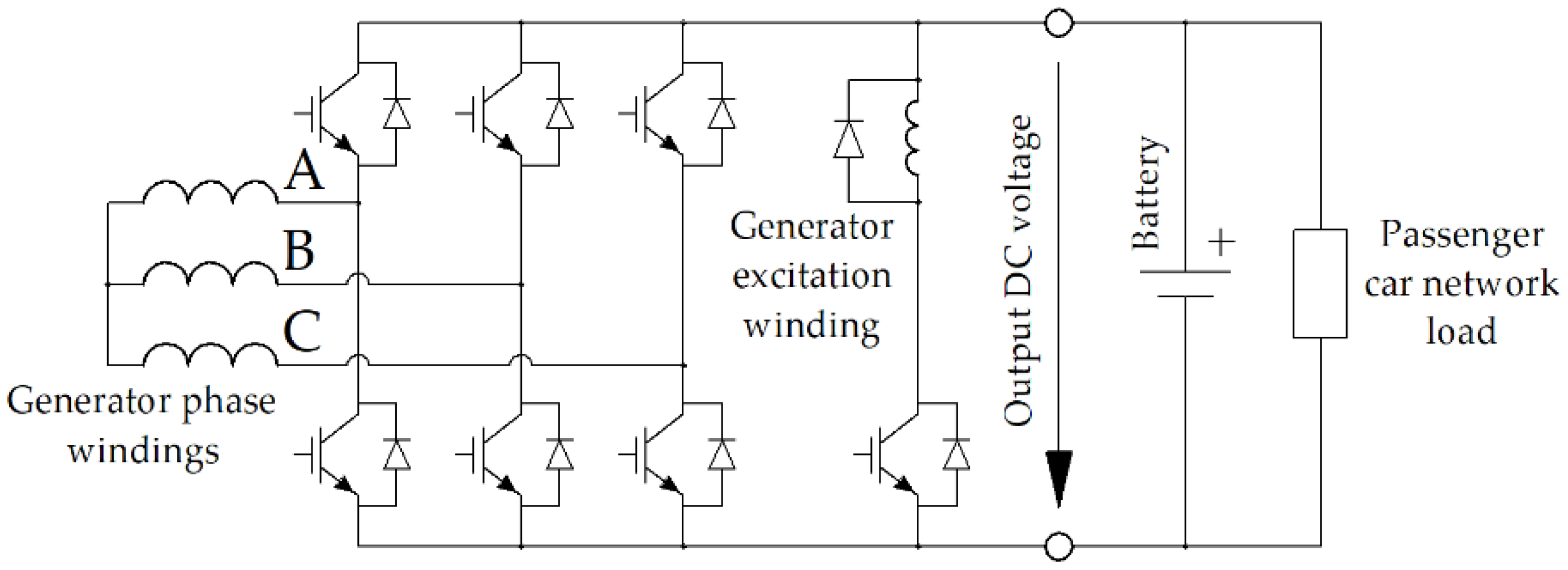

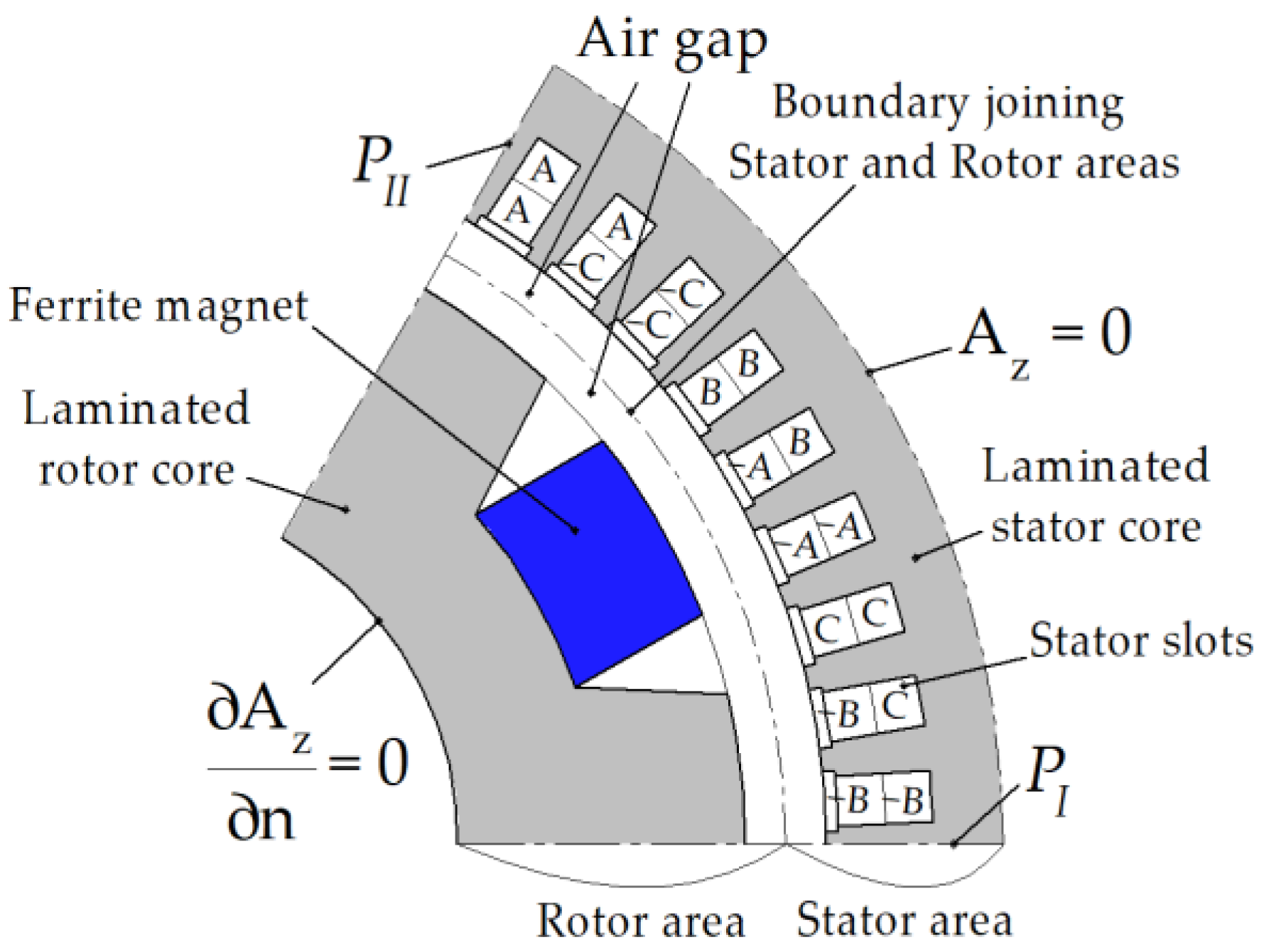
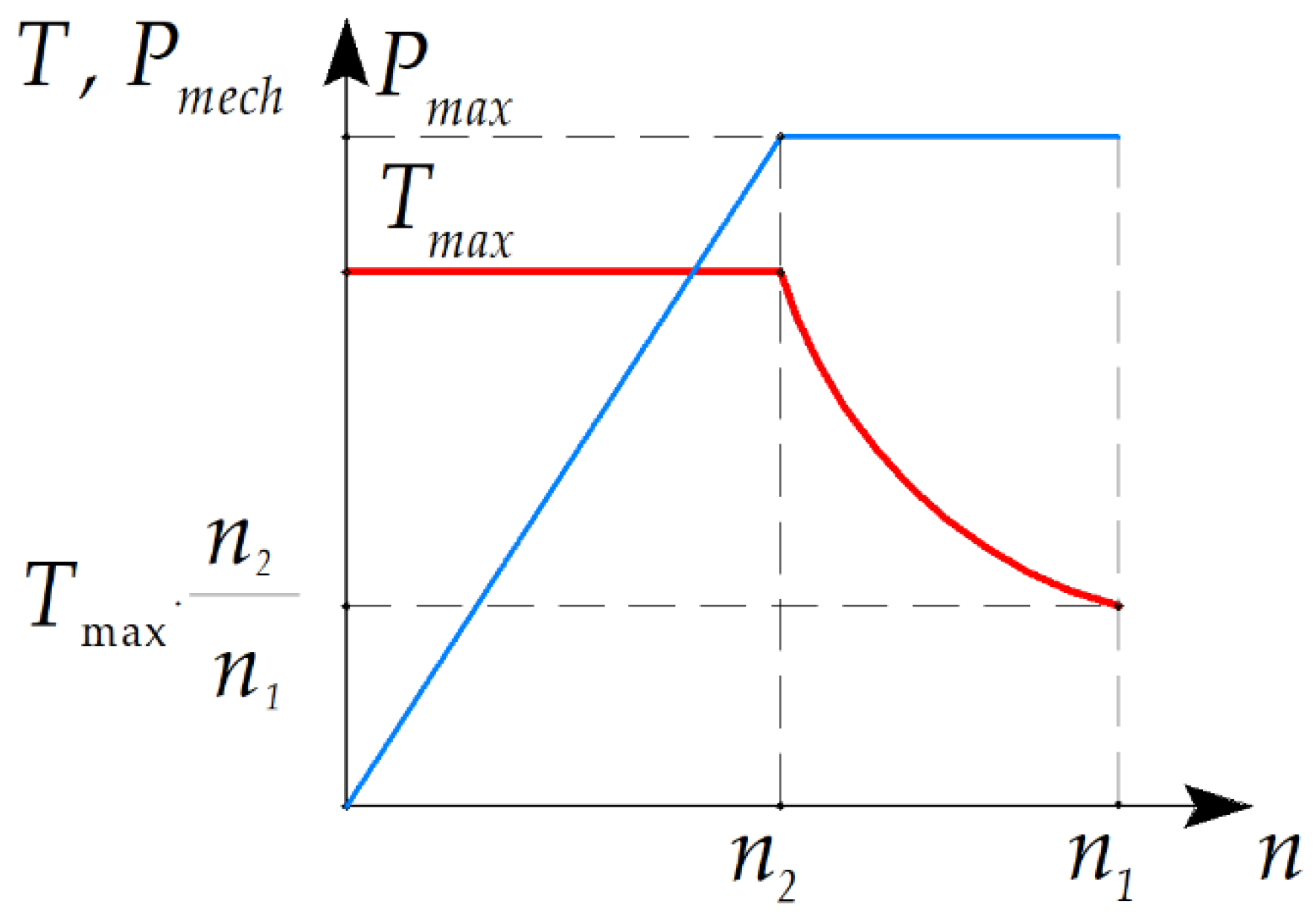
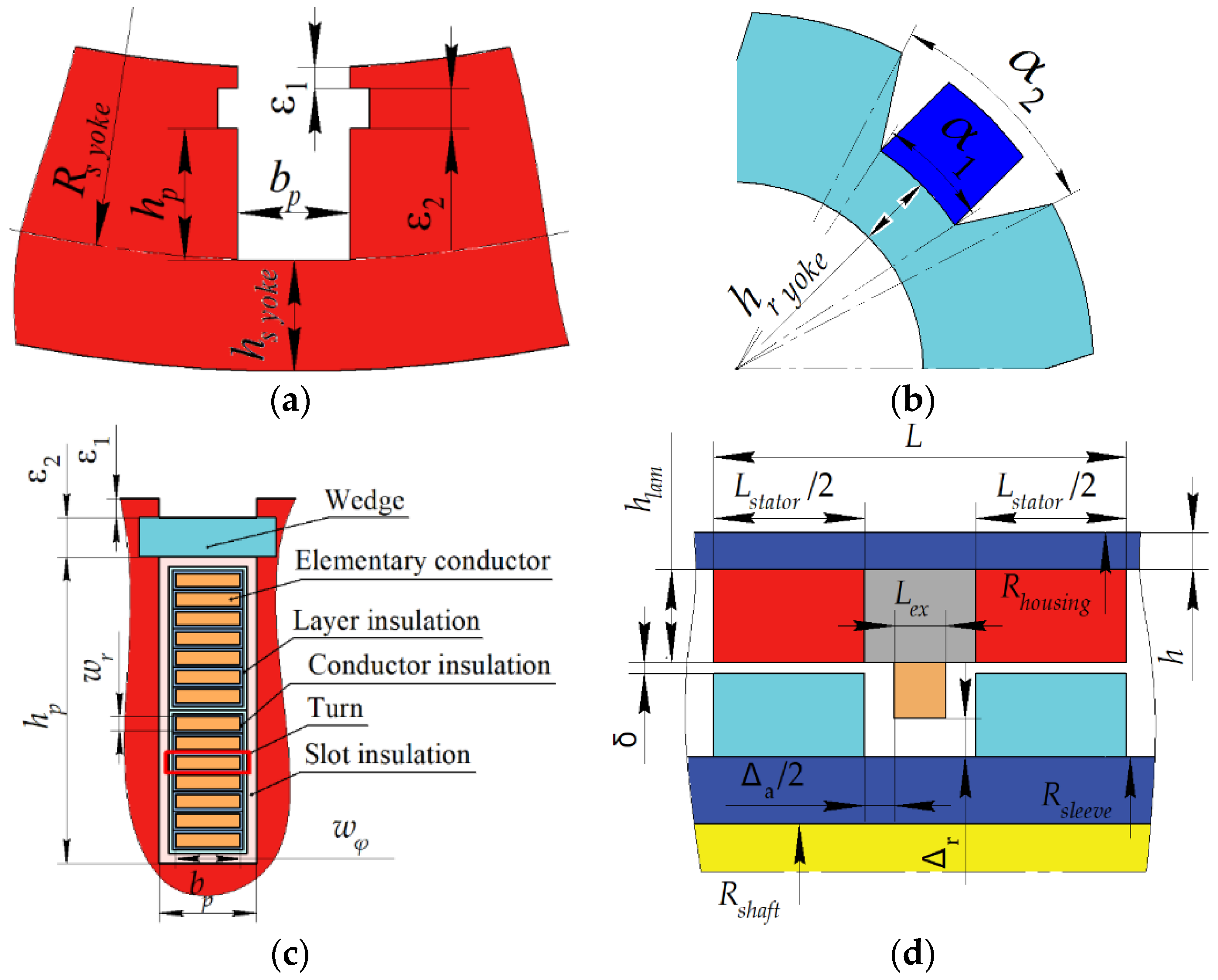
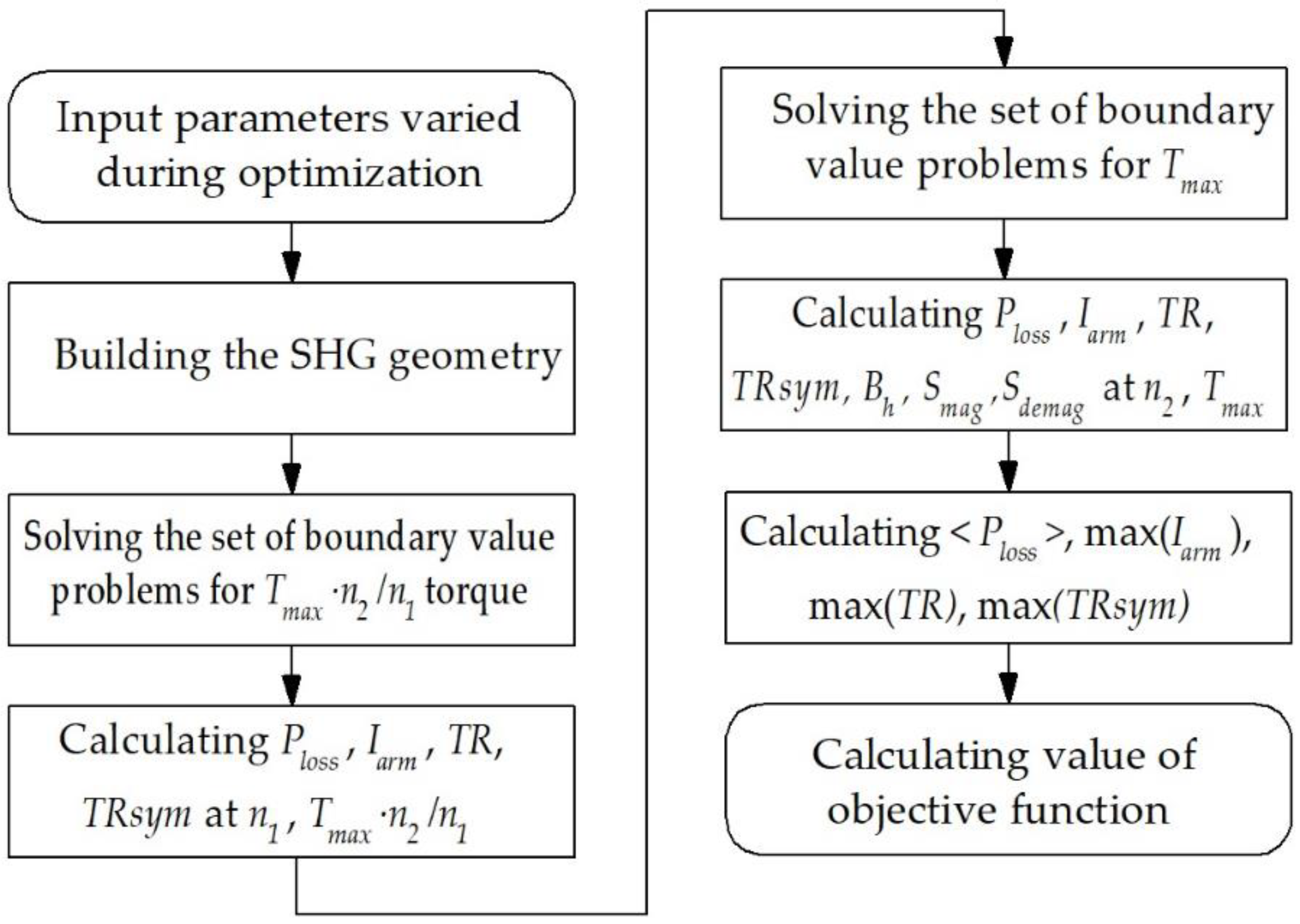

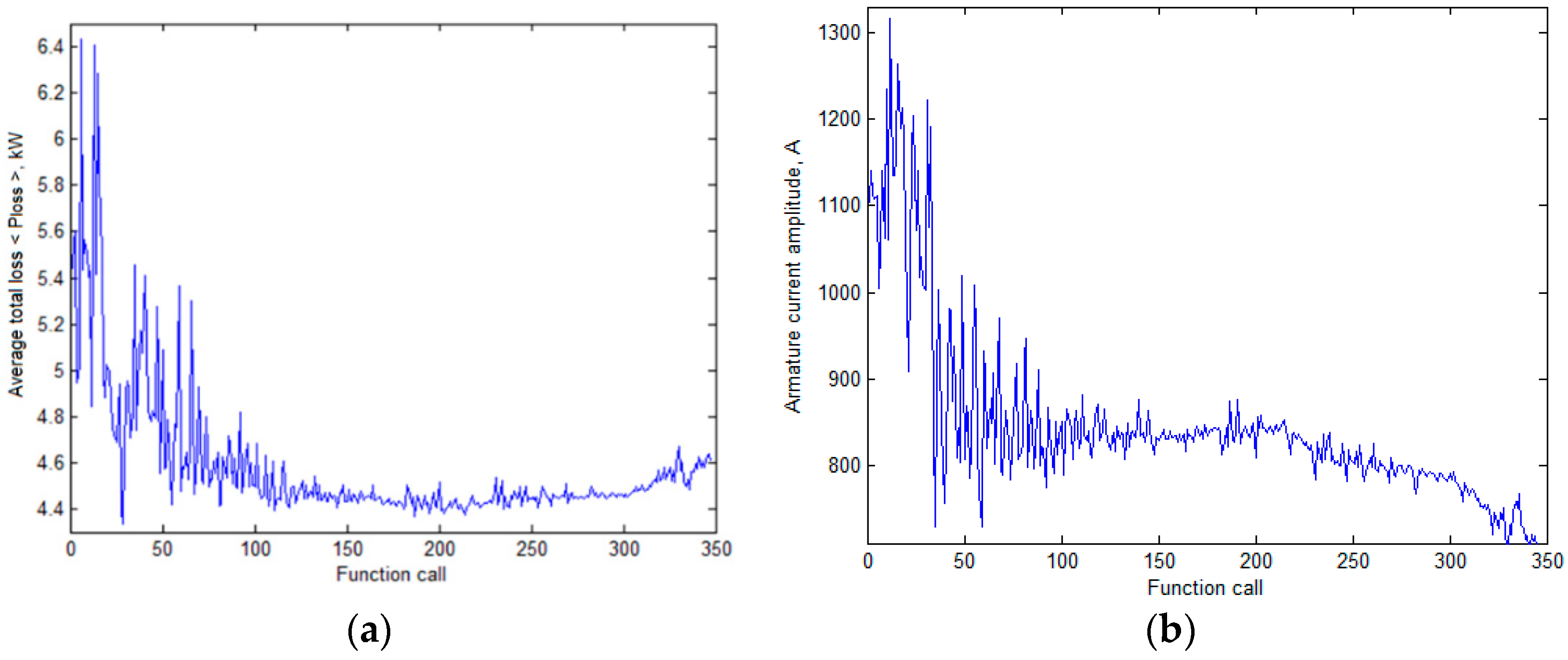
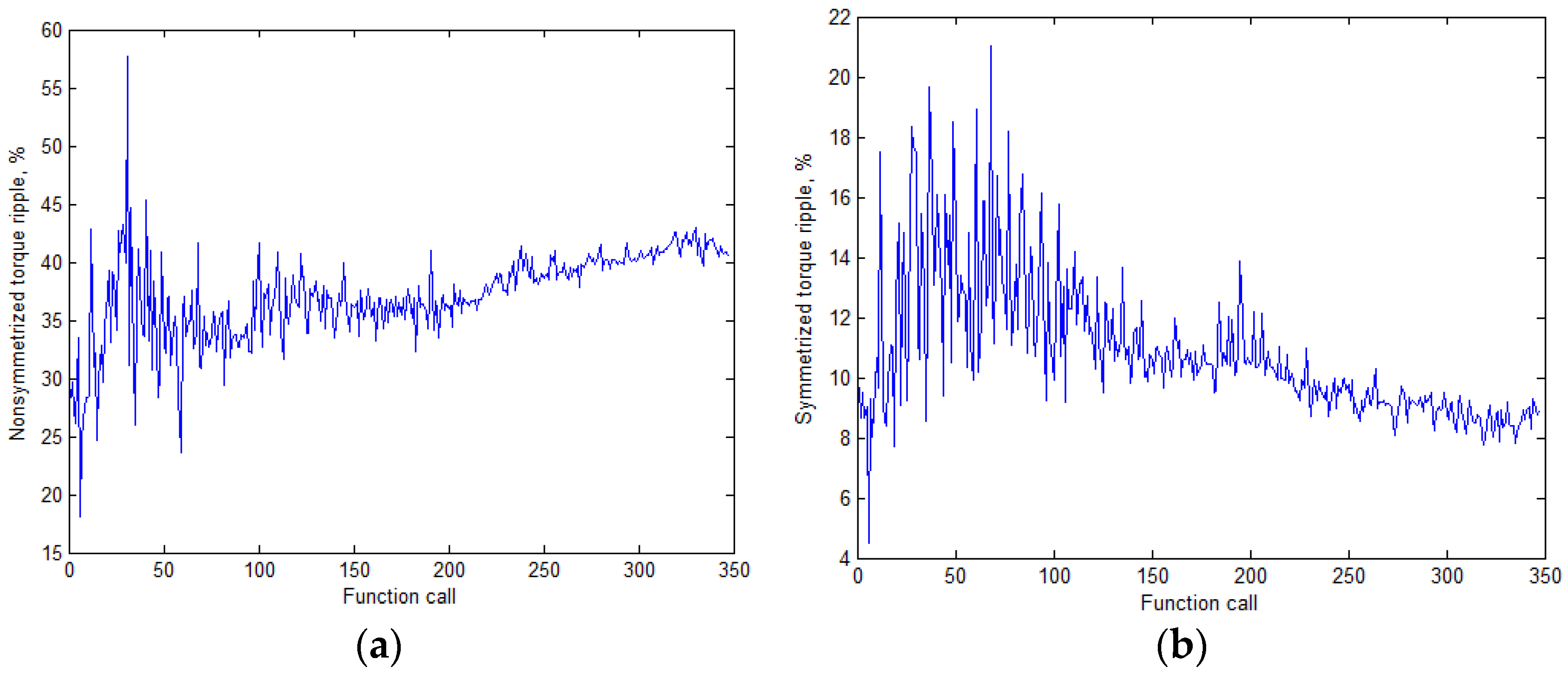

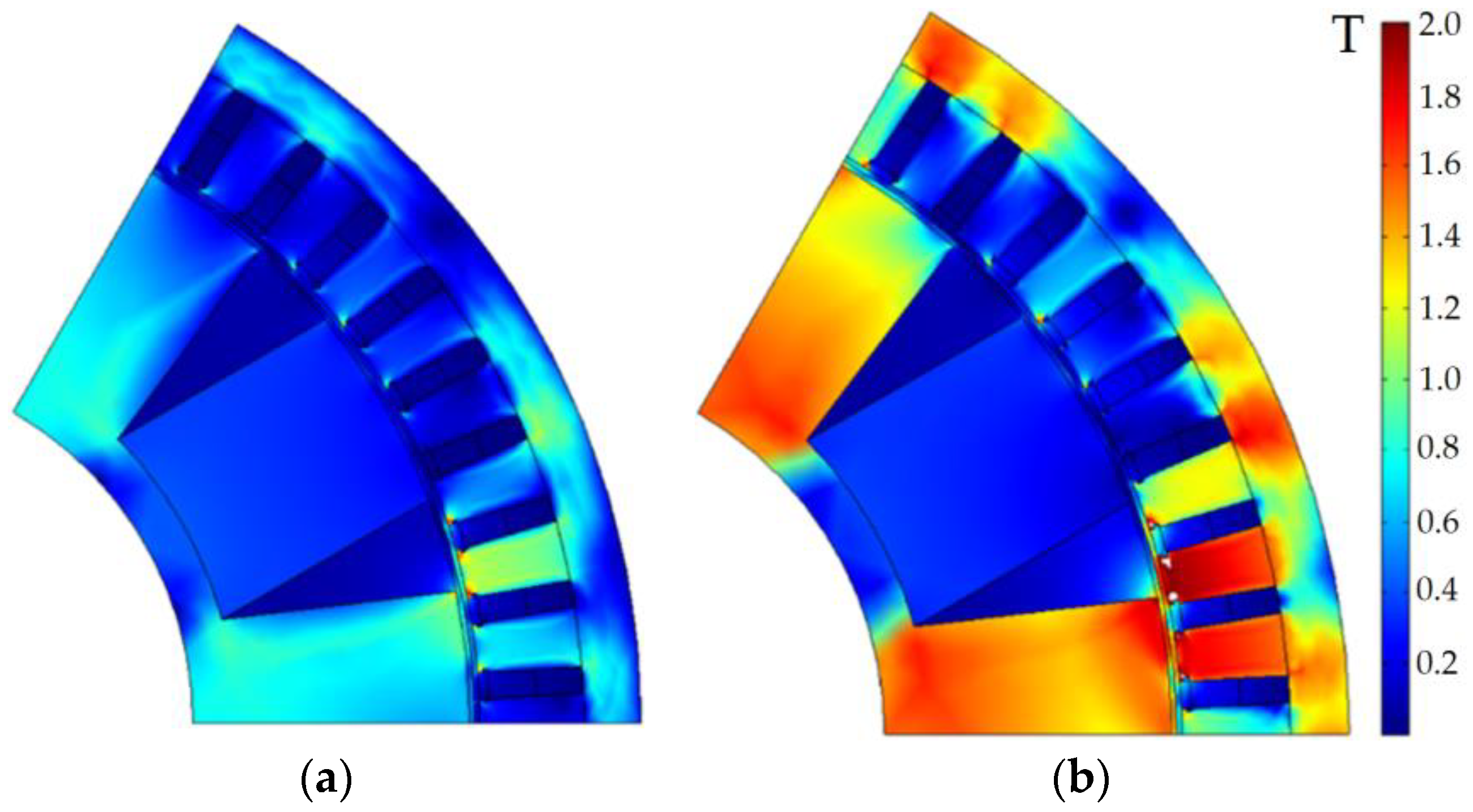
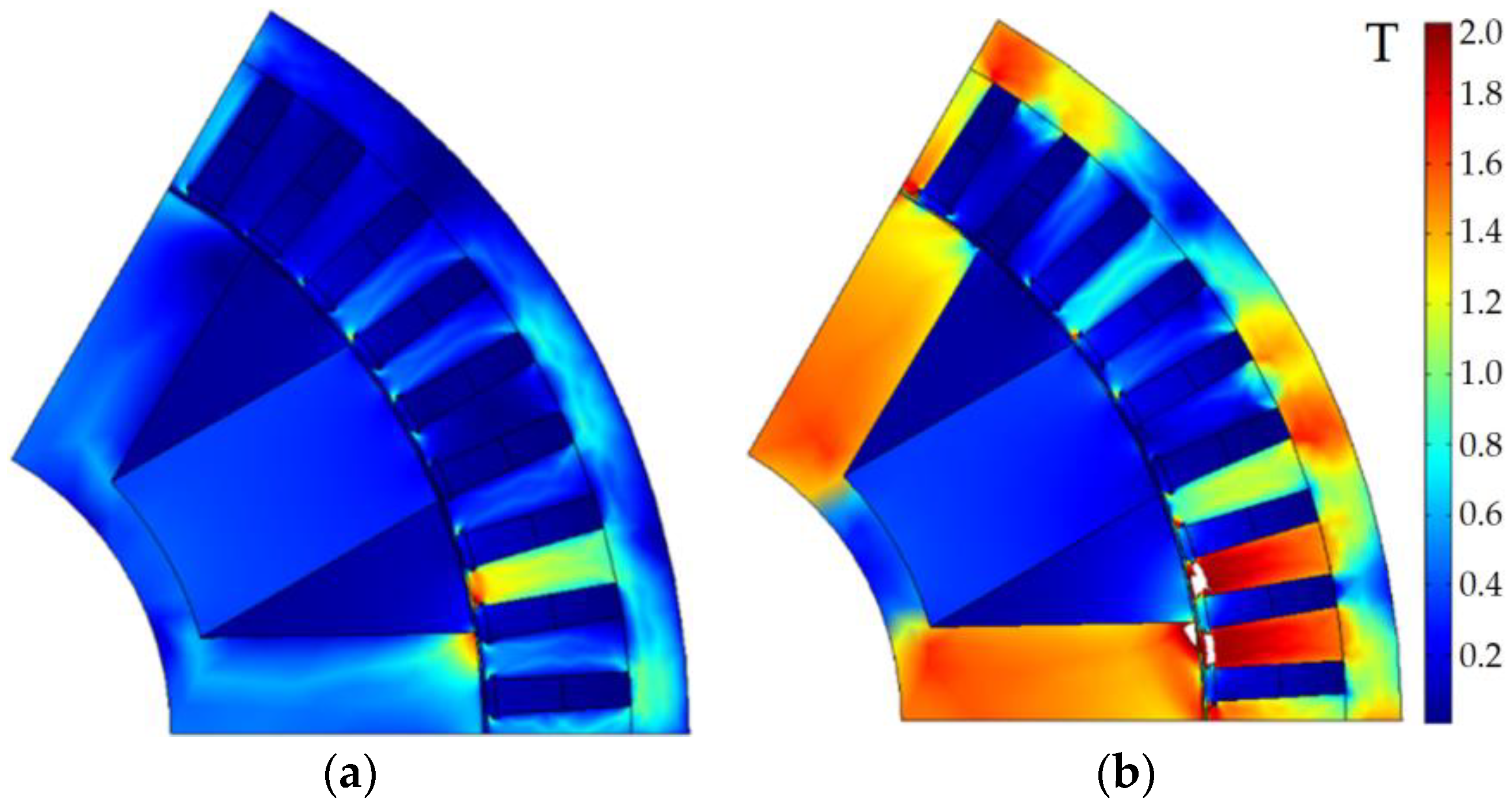

| Characteristics | Values |
|---|---|
| Length of all laminated stacks plus the axial clearances between them for installing excitation coils L, mm | 150 |
| Outer diameter of the stator housing, mm | 370 |
| Axial clearance between excitation coils and a rotor stack Δa, mm | 15 |
| Radial clearance between excitation coils and the rotor sleeve Δr, mm | 12 |
| Diameter of the rotor shaft, mm | 40 |
| Back iron width of stator lamination Hstator yoke, mm | 12 |
| Back iron width of rotor lamination Hrotor yoke, mm | 9 |
| Thickness of the stator wedge, ε2, mm | 1 |
| Stator tooth tip height ε1, mm | 1 |
| Current angle at 750 rpm, electrical radian | 0.1 |
| Grade of electrical steel | 2412 |
| Thickness of electrical steel, mm | 0.35 |
| Characteristics | Initial Design, x0 | Optimized Design, x |
|---|---|---|
| Housing thickness h, mm | 15 | 11.07 |
| Total stator stacks length Lstator, mm | 130 | 128.3 |
| Stator slot depth hp, mm | 20 | 27.9 |
| Stator slot width bp, mm | 5 | 6.37 |
| Airgap width δ, mm | 2 | 0.91 |
| Rotor slot thickness, α1 | 0.5∙tz * | 0.481∙tz * |
| Rotor slot thickness, α2 | 0.6∙tz * | 0.689∙tz * |
| Angle of field weakening at 3450 rpm, electrical radian | 0.6 | 0.93 |
| Current ratio ** @ 750 rpm | 8 | 14.54 |
| Current ratio ** @ 3450 rpm | 8 | 9.76 |
| Characteristics | Initial Design | Optimized Design | ||
|---|---|---|---|---|
| Loading case, i | 1 | 2 | 1 | 2 |
| Rotational speed n, rpm | 3450 | 750 | 3450 | 750 |
| Armature phase current amplitude Iarm, A | 408 | 1035 | 375 | 700 |
| Efficiency, % * | 94.5 | 78.0 | 92.7 | 84.4 |
| Mechanical power on the generator shaft Pmech, kW | 40 | 40 | 40 | 40 |
| Shaft torque, N∙m | 111 | 510 | 111 | 510 |
| Output electrical power P1, kW | 37.97 | 32.36 | 37.22 | 34.90 |
| Armature DC copper loss Parm DC, kW | 1.12 | 7.21 | 1.29 | 4.51 |
| Armature eddy-current copper loss Parm AC, W | 123 | 46 | 402 | 157 |
| Stator laminated steel loss Piron st, W | 756 | 379 | 960 | 411 |
| Rotor laminated steel loss Piron rt, W | 33 | 9 | 121 | 24 |
| Excitation copper loss Pex, W | 187 | 1170 | 151 | 1123 |
| Total loss Ploss, kW ** | 2.22 | 8.81 | 2.93 | 6.22 |
| Average losses <Ploss>, kW | 5.51 | 4.58 | ||
| Turns number in the armature slot | 4.41 | 6.82 | ||
| Required rectifier power, kW | 104.0 | 70.3 | ||
| Power factor | 0.926 | 0.804 | 0.989 | 0.854 |
| Line-to-line voltage amplitude Varm, V | 116.0 | 44.9 | 116.0 | 67.4 |
| Nonsymmetrized torque ripple, % | 35 | 28 | 56 | 41 |
| Symmetrized torque ripple, % | 9.8 | 4.3 | 8.6 | 4.5 |
| Flux density in the non-laminated parts of the magnetic core, T | 0.4 | 1.3 | 0.1 | 1.5 |
| Characteristics | SHG without Magnets | SHG with Ferrite Magnets | ||
|---|---|---|---|---|
| Loading case, i | 1 | 2 | 1 | 2 |
| Rotational speed n, rpm | 3450 | 750 | 3450 | 750 |
| Armature phase current amplitude Iarm, A | 369.5 | 676.2 | 375 | 700 |
| Efficiency, % | 90.4 | 79.8 | 92.7 | 84.4 |
| Mechanical power on the generator shaft Pmech, kW | 40 | 40 | 40 | 40 |
| Shaft torque, N∙m | 111 | 510 | 111 | 510 |
| Output electrical power P1, kW | 36.58 | 33.12 | 37.22 | 34.90 |
| Armature DC copper loss Parm DC, kW | 1.90 | 6.37 | 1.29 | 4.51 |
| Armature eddy-current copper loss Parm AC, W | 417 | 131 | 402 | 157 |
| Stator laminated steel loss Piron st, W | 961 | 403 | 960 | 411 |
| Rotor laminated steel Piron rt, W | 192 | 26 | 121 | 24 |
| Excitation copper loss Pex, W | 368 | 1169 | 151 | 1123 |
| Total loss Ploss, kW | 3.84 | 8.10 | 2.93 | 6.22 |
| Average losses | 5.97 | 4.58 | ||
| Turns number in the armature slot | 7.75 | 6.82 | ||
| Required rectifier power, kW | 67.9 | 70.3 | ||
| Power factor | 1 | 0.747 | 0.989 | 0.854 |
| Line-to-line voltage amplitude Va, V | 116.0 | 75.3 | 116.0 | 67.4 |
| Nonsymmetrized torque ripple, % | 97.8 | 47.0 | 56 | 41 |
| Symmetrized torque ripple, % | 11.3 | 4.5 | 8.6 | 4.5 |
| Flux density in the rotor sleeve and in the stator housing, T | 0.84 | 1.60 | 0.1 | 1.5 |
| Characteristics | SHG without Magnets | SHG with Ferrite Magnets |
|---|---|---|
| Stator laminated steel weight, kg | 34.2 | 28.0 |
| Rotor laminated steel weight, kg | 15.6 | 17.1 |
| Copper weight of armature winding, kg | 17.8 | 14.7 |
| Copper weight of excitation winding, kg | 2.44 | 2.62 |
| Weight of ferrite magnets, kg | - | 7.88 |
| Weight of structural steel of the rotor sleeve and stator housing, kg | 53.2 | 29.2 |
| Total weight of the active materials and the structural steel, kg | 123.24 | 99.5 |
| Stator laminated steel cost, USD | 34.2 | 28.0 |
| Rotor laminated steel cost, USD | 15.6 | 17.1 |
| Copper cost of armature winding, USD | 124.6 | 102.9 |
| Copper cost of excitation winding, USD | 17.1 | 18.3 |
| Cost of ferrite magnets, USD | - | 145.5 |
| Cost of the structural steel, USD | 53.2 | 29.2 |
| The total cost of the active materials (permanent magnets, copper, electrical steel) and low carbon steel of the stator housing of the rotor sleeve, USD * | 244.7 | 341.0 |
| Length of all stacks of the stator laminated steel, mm | 152.7 | 128.3 |
| Length of all laminated stacks plus the axial clearances between them for installing excitation coils, mm | 180 | 150 |
| Laminated stator external diameter, mm | 370 | 370 |
| Air gap, mm | 0.88 | 0.91 |
Disclaimer/Publisher’s Note: The statements, opinions and data contained in all publications are solely those of the individual author(s) and contributor(s) and not of MDPI and/or the editor(s). MDPI and/or the editor(s) disclaim responsibility for any injury to people or property resulting from any ideas, methods, instructions or products referred to in the content. |
© 2023 by the authors. Licensee MDPI, Basel, Switzerland. This article is an open access article distributed under the terms and conditions of the Creative Commons Attribution (CC BY) license (https://creativecommons.org/licenses/by/4.0/).
Share and Cite
Prakht, V.; Dmitrievskii, V.; Kazakbaev, V. Analysis of Performance Improvement of Passenger Car Synchronous Homopolar Generator with the Addition of Ferrite Magnets. Appl. Sci. 2023, 13, 3990. https://doi.org/10.3390/app13063990
Prakht V, Dmitrievskii V, Kazakbaev V. Analysis of Performance Improvement of Passenger Car Synchronous Homopolar Generator with the Addition of Ferrite Magnets. Applied Sciences. 2023; 13(6):3990. https://doi.org/10.3390/app13063990
Chicago/Turabian StylePrakht, Vladimir, Vladimir Dmitrievskii, and Vadim Kazakbaev. 2023. "Analysis of Performance Improvement of Passenger Car Synchronous Homopolar Generator with the Addition of Ferrite Magnets" Applied Sciences 13, no. 6: 3990. https://doi.org/10.3390/app13063990







